
Music theory is a super powerful tool for guitar players. It helps you navigate the fretboard, makes it easier to communicate with other musicians and deepens your understanding of music. In short: music theory can make you into a better guitarist and musician.
The journey of learning music theory as a guitarist can be a bit overwhelming though.
What’s the best place to start? What are the most useful things to learn? And what's the best way to learn those things?
This article will answer all those questions. I'll give you a step-by-step roadmap of how to learn music theory as a guitar player.
You’ll discover what theory is the most useful and in what order you should learn it. By the end, you’ll know exactly what your next step should be to learn music theory.
So let’s start at the beginning. When are you ready to start learning theory?

Make sure you never get lost learning music theory with my Music Theory for Guitar Cheat Sheet.

Wherever you are in your journey, it shows you what to learn next.
It makes sure you always know your next step, so you can master music theory faster!
+Bonus: I’ll also share 3 mistakes guitarists make when learning music theory (and how to avoid them)
Don’t miss out and click below to get your FREE guitar music theory resources!
Introduction
When should you learn music theory?
That makes music different from many other activities, such as board games or sports. To play a game of soccer for example, you need to know that you’re not allowed to use your hands, and how you can score goals. Without knowing the rules, you can’t play.
By contrast, music theory doesn’t tell us what we can and can’t do. It doesn’t provide a set of ‘rules’ that tell us how to play music ‘correctly’. We can do anything we like. There’s really only one rule: if it sounds good, it is good!
But, if music theory doesn’t tell us what to do, then what is it for?
Music theory is a tool that helps us understand why music sounds the way it does. It gives names to things, which makes it easier to talk and think about music.

Compare it with a painter learning the names to colours. When you know about red and yellow, you can understand that orange is actually a mix of those two colours. (Sidenote: click here for a more detailed explanation of what music theory is.)
So, ok: you might not need music theory to play music, but it does help us to understand music. Does that mean you start learning it as soon as you start learning your instrument?
In short: no.
Here’s why.
As we saw earlier, music theory gives names to a whole bunch of things, like chords, scales and rhythms. Now the thing is, it's easier to remember what something's called once more of your senses have been exposed to it. After seeing, smelling, feeling and tasting a dish of food, it's easier to remember its name, than after reading a dictionary definition of it, right?

Compare this delicious picture with the Wikipedia definition: “Pizza is a dish of Italian origin consisting of a usually round, flat base of leavened wheat-based dough topped with tomatoes, cheese, and often various other ingredients, which is then baked at a high temperature, traditionally in a wood-fired oven.”
In the same way, it’s much easier to understand what, for example, the 'myxolydian scale' or a ‘major seventh chord' is when the way it sounds reminds you of a couple of songs you like to play. In short, with some musical experience under your belt, music theory will be easier to learn and more useful. (Which makes it more rewarding to learn too!)
Moreover, when you’re learning to play music for the first time, you have your hands full. There’s a lot to playing the guitar, and I know many newcomers find it a little overwhelming at the start. So when you’re just starting out, focus on the thing that matters the most: playing music!
So, when are you ready to get into music theory?
Obviously, there’s no one-size-fits-all answer. But a good indicator that it’s time to start exploring music theory is that you have questions that you want answered. Questions like:
- Why do these two chords sound so good together?
- What is this fretboard pattern I’ve seen in so many songs?
- What do the numbers mean in chord names like in E7 or A7?
Let’s assume that you have those questions. And that you want to understand why the music you love sounds the way it does.
Where should you start?
Guitar Theory vs Music Theory
In short: guitar theory is simply music theory applied to the fretboard.
Guitar Theory = Music Theory + Fretboard
Now, as a guitar player you should always strive to understand how music theory applies to the fretboard. It ensures you truly understand how the theory works in practice, how it actually sounds, and how you can use it yourself. And being able to use the theory yourself is crucial. As we saw in the last section, music theory is nothing more than a tool that can help us make better music. If it remains something that you read in a book once and vaguely remember, music theory won't help you!
There's a second reason why applying theory to the fretboard straight away is a good idea. I've always found the fretboard an excellent 'cheat sheet' that made theory easier to remember. It functions like a visual aid that makes it easier to memorize things like how certain scales or chords are constructed.

This shape is forever connected to the major scale in many guitarists' brains.
In short, learning music theory and applying it to the fretboard straight away is both easier and more effective. And if you’re learning theory the right way, there is no difference between music theory and guitar theory! I like to think of it simply as music theory for guitar.
And that’s definitely the approach we’ll be taking in this guide.
Step 1
The Basic Language of Music and Guitar Theory
This first step is about getting a grip on the basic language of music theory. Some of this might seem obvious, but it’s good to check if you’ve got this stuff covered before we move on.
1. Rhythm basics
Time is the canvas of music. Now, while timing is something we tend to do without thinking about it all that much, it helps to learn about the basics of rhythm and time. Most importantly, you need to know how music is made up out of beats, and how we divide those beats into groups called a ‘measure’ or a ‘bar’. I’ve covered it in this quick, 1-minute video for my course Strumming Skills Bootcamp, check it out:
2. The basics of note names
Notes have names. Those names are letters such as C, A, F and G. Sometimes, notes also have names such as Gb (pronounced ‘G flat’) or A# (pronounced ‘A sharp’).
Of course, there’s a logic behind those note names with '#' and ‘b' in it, but for now it doesn’t matter. (You’ll learn it later though!)
What’s most important at this point is that you know is that we use the letters A to G to give names to notes, and sometimes add sharps (#) or flats (b) to those letters.
3. Familiarity with chord names
One of the first things any guitarist learns is chords. These chords have names such as ‘E’, ‘Am' or ‘B7’.
You’ll learn about the logic behind these names soon. For now the most important thing is to get comfortable using these chord names and to know that ‘Am' stands for ‘A minor’ and that B7 is pronounced as ‘B seven’.
So, how many of the chords names should you be familiar with? A good thing to aim for is to learn your open guitar chords. You don’t have to learn all of them, but be sure to learn at least a few from each of these rows:
Major: E, F, G, A, C, D
Minor: Em, Am, Dm
Minor Seven: Em7, Am7, Dm7
Major Seven: Fmaj7, Amaj7, Dmaj7, Dmaj7
Dominant: E7, A7, C7, D7
Bonus points if you’ve learnt barre chords as well, and can play chords like Abm7 or Bb7!
Step 2
Intervals
Intervals are like the building blocks of music. They allow us to understand how things like chords, scales, melodies and chord progressions are constructed. They’re the foundation for understanding music theory.
So what exactly are intervals?
An interval is the distance between two notes. That distance can be large, like when you play the lowest note on your guitar, and then play another note way up the guitar neck. But it can also be small, such as when you play a note, and then play another note that’s just one fret higher.
The reason intervals are important is that they determine the relationships between notes. And to understand music, those relationships are even more important than the actual names of the notes.
Here’s a quick explainer of why that is, from my guitar theory course Music Theory from Scratch.
Now, we could refer to the distances between notes with something like ‘three frets’ or ‘seven piano keys’. But instead, each interval has a name, such as:
- major third
- perfect fifth
- minor seventh
For now, the logic behind these names doesn’t matter. We’ll get into that as we learn about chords and scales.
The most important thing right now, is to learn how to play these intervals on guitar.
Let’s take an example. The perfect fifth interval is the same distance as seven frets on the guitar fretboard. So if we’re starting with the open E string and want to play the note that’s a perfect fifth higher, we’d need to go up seven frets.
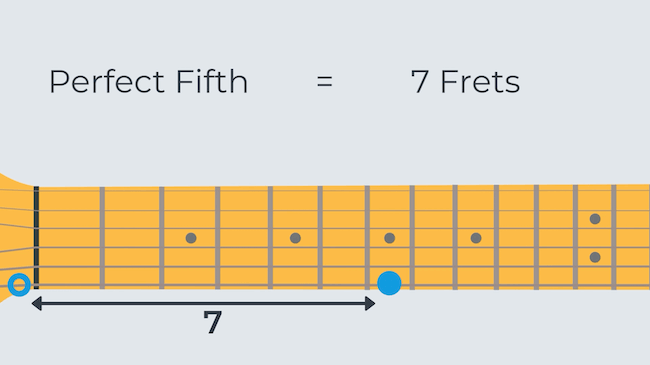
We can do the same thing from any place on the fretboard. For example, if we start on the third fret of the low E string, we could play a perfect fifth like this.
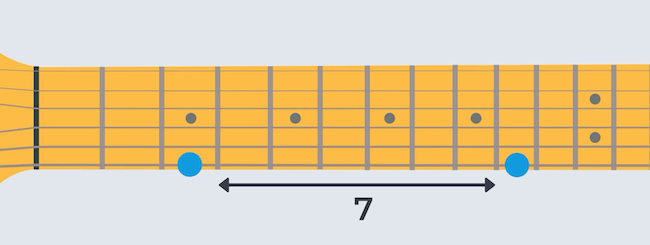
We can also play a perfect fifth interval by going to a different string. This requires a little bit of math, but it’s more comfortable to play.
First, we go up one string, which is the same as five frets on the guitar. Next we go up two frets, which gets us to a total of seven. So we could also play a perfect fifth like this:
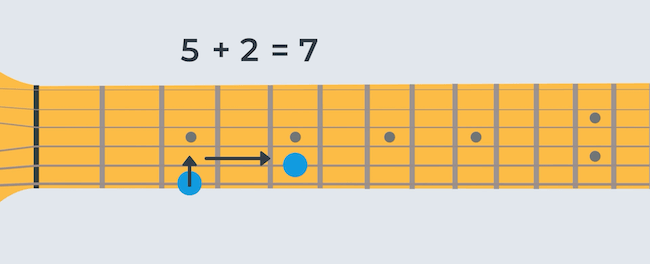
You can play a perfect fifth like this anywhere on the fretboard! There's just one important exception you need to keep track of. When you go up one string from the G to the B string, this isn't the same as going up five frets, but only four frets! So to play a perfect fifth on the G string, would look like this:
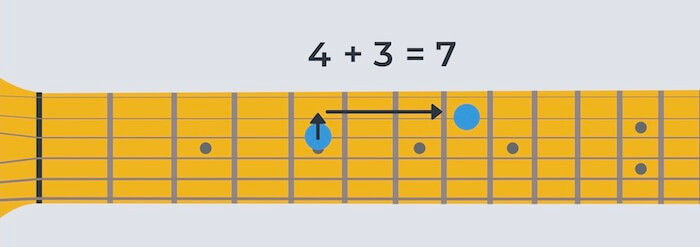
The same logic applies to all intervals! All you need to know is how many frets on the guitar each interval is.
Here’s the full list:
Don’t try to memorise all of these at once though! Before you move on to the next step (chord construction), I’d recommend learning to play the following intervals on guitar:
If you're a StringKick All Access Member, you can get started with this right away with Music Theory from Scratch. The first section is all about intervals.
Not a member yet? You can still get going right now. Try the first couple of lessons from Music Theory from Scratch for free.
In those first few lessons, you'll play three different intervals and use it to analyse a simple guitar riff. We'll even use theory to change that riff into something cooler.
Step 3
Chord Construction
There are different chord ‘types’. For example, we have:
- major chords, such as E, C or G
- minor chords, such as Em, Cm or Gm
- dominant chords, such as E7, C7 or G7
Each chord type has a distinct sound or mood. You could compare them to a dish of food, each with its own flavour that we can learn to recognise. Like a dish, each chord type has its own ‘recipe’. This recipe doesn’t consist of note names (such as A, C# and F), but of intervals. For example, a major chord consists of the following ‘ingredients’: a root note, a major third and a perfect fifth.
Here’s how that works.
We start with the lowest note. This note is called the root note. Next, we look at the interval (i.e. the distance) between the root note and the other notes.
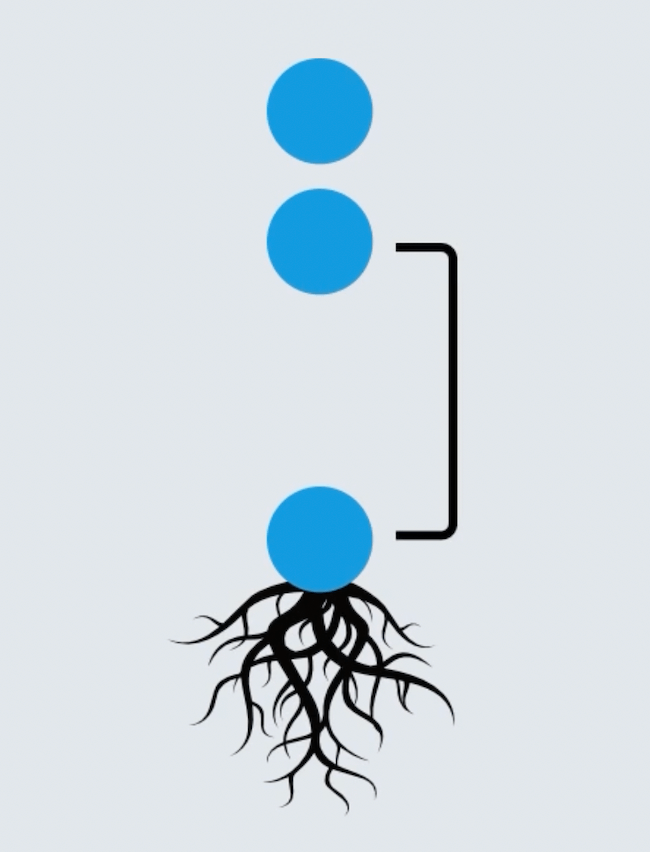
For example, in a chord consisting of three notes, that distance might be a major third (four frets) and a perfect fifth (seven frets).
Now, knowing this in theory is one thing, but to make this really useful, you need to know how it applies to the guitar.
When you know how to play intervals anywhere on the fretboard, you can create or analyse any guitar chord as well. For example, take a look at this ‘analysis’ of a G chord.
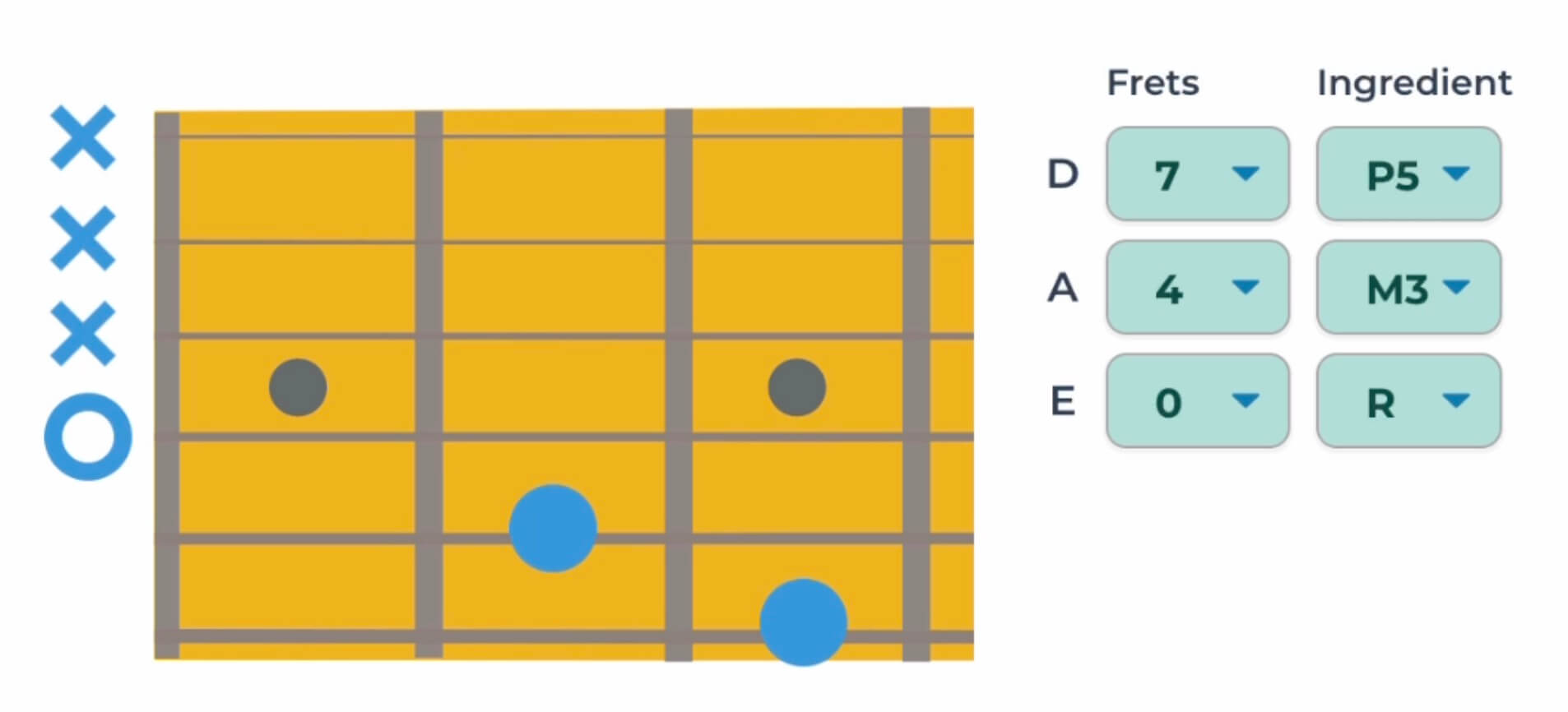
R = Root, M3 = Major Third, P5 = Perfect Fifth.
As you can see, we can use intervals to identify all the ‘ingredients’ in a guitar chord. And knowing that, we can figure out what chord we’re dealing with.
Want to give that a try yourself? One of the exercises in Music Theory from Scratch is this interactive quiz:
You can try a couple of lessons about chord construction for free. In addition to the quiz above, it has a more detailed explanation of how chords are constructed.
Of course, seeing the logic in chord shapes also helps you when you want to understand the guitar part in a song.
Because guitar theory should be practical, we'll check out another quiz from Music Theory from Scratch featuring this Lizz Wright tune. First, take a listen to the guitar. Then use the buttons below the TAB to indicate what 'ingredient' each of the notes is in the chord.
Now, what's cool about knowing how this theory applies to the fretboard is that we can start to change chord shapes to create different chords.
Above, we saw that the ‘recipe’ for a major chord is:
The ‘recipe’ for a minor chord is similar. There’s only one difference: we’ll change the major third into a minor third:
Knowing this, we can take any major chord we know and turn it into a minor chord by changing just one note.
For example, this is a D chord:
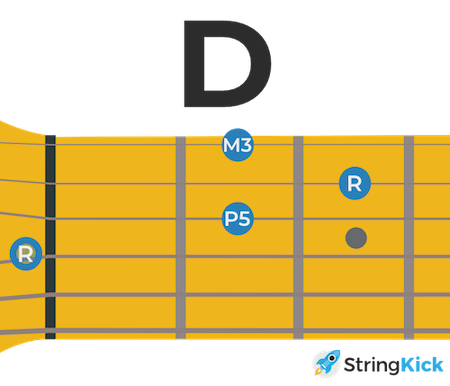
And here's a D minor chord:
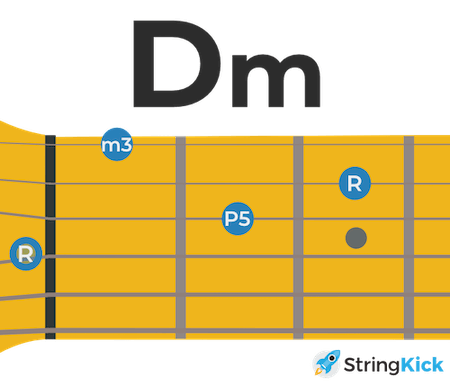
Cool right? I hope you’re starting to see how much theory can really help us out once we understand how it all applies to the fretboard!
To wrap up this step, I’d recommend you learn the chord ‘recipe’ for the following chord types:
- Major
- Minor
- Dominant
- Minor Seventh
- Major Seventh
Naturally, be sure to learn how these recipes apply to the fretboard. That’s what makes the theory useful in everyday playing.
Once you feel (reasonably) comfortable with this, it’s time to move on to the next step: scales!
Step 4
Scales
Say we take a song and write down every note that’s used in it. Pretty quickly, you’ll notice something striking: some notes are used over and over again, while other notes aren’t used at all. In fact, you’ll see that most songs use no more than seven notes.
That group of seven notes is a scale. For some reason, it sounds good to the human ear when we stick to using notes from the same scale when we’re singing a melody or playing a bunch of chords.
Now, scales aren’t just any random collection of notes. In the last step (chord construction), we saw how different chord types have a so-called 'recipe' consisting of several intervals. Scales work in the same way. We have different scales and each one has its own unique ‘recipe' of intervals.
The Major Scale
The first and most important scale to learn is called the major scale. Here’s the recipe:

Knowing this ‘recipe’, we can figure out how to play the major scale on the guitar fretboard too. Here’s what that would look like:

You might notice that I haven’t indicated in which position on the fretboard you’d play this. That’s because you can play it in any fret of the low E string! You can move this pattern to any position and you’ll still be playing the major scale.
Now, armed with our knowledge of the scale and how to play it on the fretboard, we can go start analysing melodies and see their underlying structure.
Here’s an example of what such an analysis would look like:

This melody starts on the root (R), as many melodies do. It then goes up to the major third (M3), perfect fourth (P4) and perfect fifth (P5). After playing around with the major third (M3) and major second (M2) it finally lands on the root note (R) again.
The best way to practice analysing melodies is of course to do it yourself! Here’s a song by The Shins. We’ll analyse the opening riff. For each note, indicate what interval we’re dealing with using the buttons below!
Hope that went well for you! Analysing songs like this is a great way to become more and more familiar with scales, how they apply to the guitar and are used in real music!
The Natural minor scale
Everything we just learned about the major scale, also applies to the natural minor scale! The natural minor scale (also known as aeolian), has the following ‘recipe’:

Just like we did with the major scale in step 4, we can analyse a melody using our knowledge of the natural minor scale. Check it out with this next tune by Gorillaz.
To get better (and faster) at applying the theory of scales to the fretboard, check out Music Theory from Scratch. It explains all of this in depth, and has many more songs to analyse! Naturally, if you're an All Access member, you'll get full access to the course (and many others)!
Step 5
Roman Numerals

This is pretty cool, because it allows you to:
- Understand why some chords sound good together, while others don’t.
- See the same patterns come up again and again in different songs.
- Analyse why a song might sound uplifting or moody.
So, how exactly does this work?
Without going into too much detail here, the short explanation is that chords that sound like they belong together, use notes from the same scale. When a chord progression only uses notes from the same scale, we call that progression ‘diatonic’. (The dictionary definition of diatonic is ‘relating to a musical scale’.)
Let’s explore how that works in practice. The major scale for example, consists of seven notes. Using those seven notes, we can create seven different chords. With the notes in the A major scale, we can ‘construct’ the following chords:
As you see, we can give each of those chords its own Roman numeral. That tells us what role that chord plays in the harmony of the song. For example, the D chord has Roman numeral IV, which basically tells us 'this is the fourth chord we can create using the scale this song is based on'.
By looking at the Roman numerals instead of the chord names (i.e. A, Bm or F#m), we can see the underlying structure of a chord progression.
Let's expand our chart and add in the chords we can create using the C major scale.
Looking at this chart, we can see that the D chord in A major has the same roman numeral as the F chord in C major. They're both IV chords.
Armed with that knowledge, take a look at the following two chord progressions.
A / A / D / A
C / C / F / C
At first glance, they might not seem very similar. The chords are completely different.
But if we'd analyse these progressions using Roman numerals, we'd see that they're both a I - IV - I progression (pronounced "one - four - one"):
I / I / IV / I
This is the power of Roman numerals. They allow you to see patterns that are used all the time in music. For example, in blues and pop music, the I - IV - V progression is super common (pronounced “one four five”). And jazz tunes are full of ii - V - I progressions (“two five one”).
Here’s an example of what a Roman numeral analysis of a song would look like:
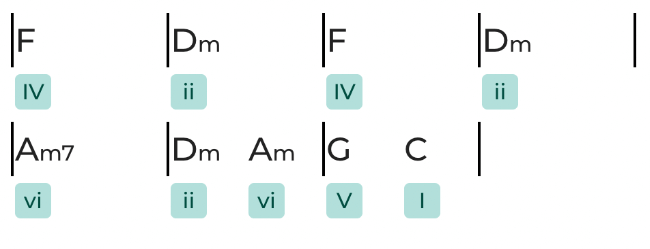
The best way to see how this works is to try it yourself. So, let’s analyse the chord progression in Boys Don’t Cry by The Cure.
This song is in the key of A, so that means it’s based on the A major scale. You can use the image above to see what chords we can make in that scale, and which Roman numeral belongs to each chord.
First give the song a quick listen, and then see if you can match the chords with the correct Roman numeral!
For more songs to analyse the chords of, check out Music Theory from Scratch!
Conclusion
Next Steps
Of course, we only scratched the surface for each of these steps! There are many more scales, chords and harmonies to learn about. But more importantly, it’s crucial to make music theory easy and automatic for yourself. For example, telling the difference between two chord types or intervals should become as simple as the difference between red and yellow.
How do you do that? How do you truly internalise theory?
There’s a simple answer to that question: apply the theory to the music you love. Take a song that you like and try to understand why you like it so much. Why do these chords sound so dramatic? What makes that melody so beautiful? Music theory can help you answer those questions.
This is how you bring music theory to life. How you make sure that, for example, a major seventh chord isn’t just something you learned in a book (or a super helpful website *ahem*), but something you’ve heard in real music. You don’t just understand it - you know how it feels.
This is the reason I focus so heavily on using real music on StringKick. I try to use as many real songs as possible for all the courses and exercises on the site, from music theory to ear training. Curious to try out this ‘real music’ approach? Consider joining the All Access Membership! I’d love to help you make your experience of music as fun, rewarding and meaningful as possible.
I hope you found this roadmap for music and guitar theory useful! As always, if you have any questions, feel feel free to send me a message.


![Title image for How to Read Chord Names and Symbols [Complete Guide]](https://www.stringkick.com/wp-content/uploads/2018/02/Read-Chord-Names-Symbols-Title-Image.png)

![Title image for How to Learn Songs by Ear [Complete Step-by-Step Guide]](https://www.stringkick.com/wp-content/uploads/2015/04/Learn-Songs-By-Ear-Orange.png)

